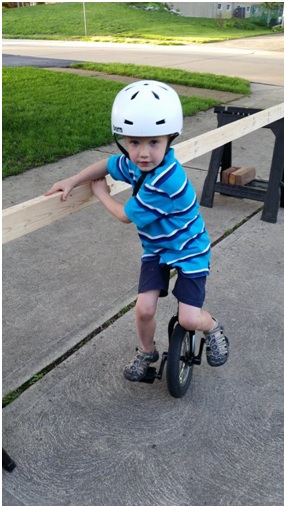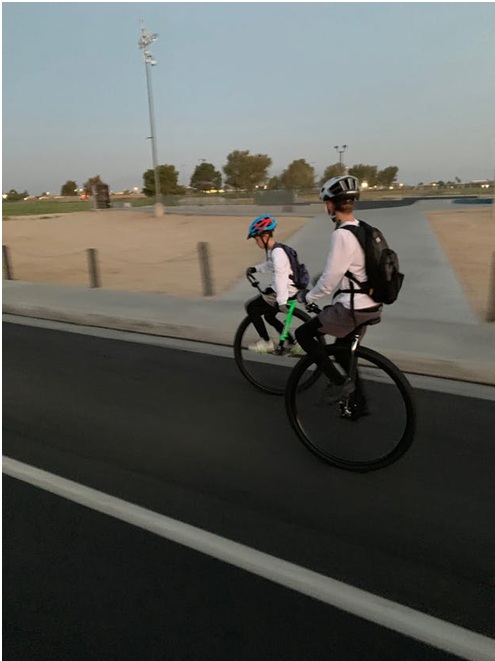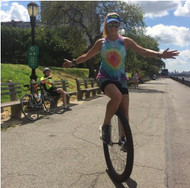By the Numbers: How Does Tire Size Affect a Unicycle’s Handling and Performance?
05/05/21
For your first-timers and any of you among them that have never ridden the one wheeler before, it will only take you a few moments to become familiar with the variability that there is in unicycles. Our unicycles are all surprisingly different and specifically equipped and differ in much greater terms than color and styling.
You’ll find tall, giraffe unicycles on our website in addition to shorter, more rugged mountain unicycles with wide tires with aggressive treads. The thing about this is that the unicycle will vary in accordance with the goal of the rider: no two unicycles are equipped to tackle the same terrain or handle the same challenges.
One particularly impactful trait of a unicycle is the size of its tire, given as a measure of diameter in inches. Here at Unicycle.com, we have everything from the smallest 12-inch unicycles for young children all the way up through unicycles with 36 or even 32 inch tires that are among the fastest.
Here’s what you need to know about how tire size will affect the speed, handling, and suitability of a unicycle to a specific riding discipline.
Young Riders: 12 to 20 Inch Tires

Generally speaking, the smallest unicycles we sell here on our website are models with 12-inch tires. You’ll notice that the dimensions of these smaller unicycles are in line with the smaller tire, but unlike our clown bike, these unicycles aren’t simply scaled back to provide a challenge - they’re ideally sized for many younger riders and children.
These exceptionally small unicycles are better for younger and smaller riders that are not yet grown enough to try riding a 16-inch unicycle. We recommended that riders with leg lengths between 19.5 and 24 inches try a 12-inch model if a 16-inch model is cumbersome or too large.
It is important to note, however, that 12-inch tires will not handle well on uneven surfaces or outside and it is advisable only to ride these smaller one-wheelers on very even, smooth surfaces. This is something you will notice that holds true across the board; the larger the diameter of the tire, the smoother the ride will generally feel. Also, larger tires respond more effectively to uneven or rough terrain as they are better able to roll over impediments.
A step up from 12-inch unicycles are 16-inch unicycles, which are also useful for younger riders and smaller learners. Riders with leg lengths between 23.5 inches and 29 inches are probably sized appropriately for these unicycles, which generally includes children between the ages of 5 and 8 years.
While 16-inch unicycles will handle uneven terrain more effectively than 12-inch models, that isn’t saying too much. They’re still highly inefficient on rough surfaces and we generally advise that they be ridden indoors or outdoors only on exceptionally smooth surfaces.
Another size of unicycle that is fairly popular with learners is the 20-inch unicycle. However, these are highly useful for some other niche uses as well.
Spotlight on 20: Why They’re So Popular
We’ve said that the 20-inch unicycle is probably, all things considered, the most popular size in unicycles. This is still a fairly small tire size, but there is a considerable difference in the circumference of the tire. It will depend on the width of the tire tube, but the extra diameter will mean that the circumference will be somewhere around 1 and a half times greater than a 12-inch model, providing a number of advantages.
For one, the 20-inch unicycle is still good for some learners as the size is still forgiving. We recommend this size for riders with leg lengths between 28 and 33 inches. With a larger diameter and circumference than 12 and 16-inch models, this tire will respond better to less even and rougher surfaces. It’s not the best, but it’s more manageable over these surfaces than smaller, more finicky models.
They’re still great for indoor riding because they have a relatively small tire, and for this reason, they are used by some athletes for unicycle basketball or unicycle hockey. They’re ideal for riding indoors on the surfaces reserved for these sports.
In addition, 20-inch unicycles are fairly agile because of the smaller size of the wheel. The lower rotational momentum makes it easier to start and stop the unicycle and makes them very responsive, particularly in the hands of an experienced rider. They can also turn very tightly and are popular among trick riders because of their handling abilities. The smaller tire size also makes them fairly suitable for controlled hopping and jumping.
The one real drawback to 20-inch unicycles is the fact that they aren’t great for distance riding. Since the diameter of a unicycle’s tire is directly tied to the top speed that a rider can reach with it, these models are limited in this capacity - but they are highly maneuverable and agile.
The 24 Inch Tire: Good for Most Adult Learners
Up a few inches from the 20-inch unicycle is the 24-inch unicycle, which is a common size among adult riders, including among adults who are just learning to ride. The larger size requires a larger inseam, and this size of unicycle is recommended for riders with leg lengths between 31 and 36.6 inches or so. This makes this size a good choice for taller adult learners as well, if a 20 inch is just too small.
As is the trend, the larger tire will handle uneven or rougher surfaces more admirably than a 20-inch unicycle, but this size has the benefits of both worlds. It can be ridden outdoors, but the relatively smaller tire size is still highly responsive and agile. For this reason, unicycles with a 24-inch tire size are popular among freestyle riders and trick riders.
A unicycle with a 24-inch tire is starting to get into the realm of mountain riding, with a decent balance between size and agility. However, a 24-inch tire is not as good for hopping and jumping as some smaller wheels, like a 20 inch.
Up a Step: 26 Inch Unicycles
There are also unicycles available on our website with 26-inch tires. This is a fairly middle-of-the-road size which, in the hands of a skilled rider, can be used to pursue a variety of different disciplines. This size lacks some of the agility of smaller tires and it is not quite as fast as larger tires - but it can tackle somewhat uneven terrain and is faster than the smaller tires that struggle with that.
This larger size makes this a good unicycle for particularly tall learners that might struggle with smaller tires. Also, despite the fact that this tire size is not ideal for jumping and hopping during mountain and trail riding, it’s still a generally suitable size for these purposes.
For riders that are interested in a 26-inch unicycle for one of these disciplines, we advise that your leg length measurements fall between 32 and 36 inches. If your measurements fall within this range, a 26-inch unicycle might be sized just right for you.
27.5 Inch Unicycles: Good for Some Mountain Riders
One of the newest sizes available to modern unicycle riders is the 27.5-inch tire. Though these tires are only slightly larger than 26-inch wheels, they are more agile and many of the 27.5-inch tires are made to be lighter and thicker than other comparable tires.
This wheel size is considered great for mountain riding because of its unique portfolio of attributes. It is neither so large that it loses its maneuverability nor too small to be effectively used to aggressively tackle tracks and trails. Muni riders should seriously consider adding a unicycle in this size range to their collection.
29 Inches: Between Mountain Riding and Commuting
When you get into the realm of 29-inch unicycles, you’re starting to stray into the territory of commuting cycles. Though 29 might be on the low end of what’s considered good for commuting or touring, the larger wheel size enables higher speeds and the tire handles better over rougher surfaces like streets and roads. It’ll actually make the ride a lot smoother.
This latter fact also means that there are some mountain unicycle riders that make use of 29-inch unicycles for mountain riding. Like the 26 and 27.5 inch wheels, the 29 is not great for hopping and jumping, but it is a good size for riding fire roads and single track. We recommend this size of unicycle tire is suitable for riders with leg lengths between 34 and 39 inches, which also makes these unicycles suitable for taller riders.
32 Inch Tires: A Good Middle Ground between Speed and Handling
We believe that unicycles with 32 inch tires deserve a little more attention. Since these unicycles are on the larger end of the spectrum, they often get overlooked in favor of the larger wheel size of 36-inch models, but this shouldn’t be the case.
Unicycles with 32 inch tires handle similarly to those with 29-inch tires; they are fairly agile and handle very well while providing a significant bump in top speed over 29-inch models. Models with 32 inch wheels can beat the top speed of most 29 inch models by about 2 or 3 miles per hour, and despite the fact that they are smaller than 36-inch models, are only slower by about 1 mile per hour. That equates to a pretty big bump in handling at the cost of little speed.
Also, with such a large circumference, 32 inch tires handle the road well and are suitable for slightly rougher terrain and riding on roads and streets. They’re also suitable for taller riders, and we recommend them for riders with leg lengths between 33.5 and 38 inches.
36 Inch Unicycles: The Biggest of the Bunch

Finally, on the larger end of the spectrum, we have unicycles with 36-inch tires, which are some of the biggest of them all. Because of the larger diameter and circumference of the tires, these wheels have the highest rotational momentum of all and so are harder to get going, stop, and control.
However, there is a positive side to this: the higher rotational momentum of the wheel means that these unicycles are great for touring and commuting and are easy to keep going. Also, the larger circumference enables the highest possible speeds of all the unicycles covered so far.
They are a little more difficult to handle, but if you’re concerned with covering a lot of ground as quickly as possible, such as a commuter would, a larger unicycle like this might be ideal for you. They’re also good for taller riders, with recommended leg lengths falling between 29.5 to 40.5 inches.
What about Tire Width?
There is one more thing to note here with respect to tires and the way they impact how a unicycle rides and handles. Tire size itself is not the only factor that will impact these traits. Tire width is another important consideration to make.
All things being equal, a thinner tire will ride more smoothly, which is why street bikes tend to have narrow tires. They don’t provide the same level of traction, but they cut back on friction and enable a smoother ride. On the flipside, wider tires with aggressive treads are more stable and provide a lot more traction on rough or uneven terrain. This is the reason that some mountain unicycles have surprisingly wide tires with deep tread patterns.
As you can see, both tire size and tire width will have a significant impact on the way a unicycle handles and how it can be used effectively. Whether you’re looking for your first ever set of “wheel” or you’re shopping for your third or fourth unicycle, we have what you need - including the counsel you can tap into for guidance. If you have any questions at all about any of our unicycles or would like some recommendations or advice, give us a call at 678-494-4962.

